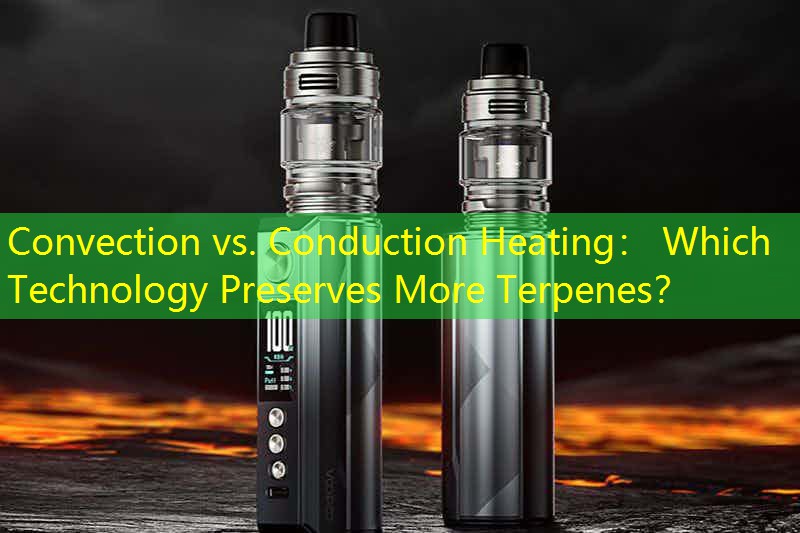הקדמה
די וועלט פון ערבאַל וואַפּאָריזאַטיאָן האט יוואַלווד דראַמאַטיקלי מיט די אַדווענט פון פאַרשידן באַהיצונג טעקנאַלאַדזשיז. צווישן די, קאַנוועקשאַן און קאַנדאַקשאַן באַהיצונג האָבן גאַינעד באַטייטיק ופמערקזאַמקייַט, ספּעציעל וועגן זייער פיייקייט צו ופהיטן די יידל טאַם קאַמפּאַונדז באקאנט ווי טערפּענעס. דער אַרטיקל וועט צושטעלן אַ טיף קוק אין קאַנוועקשאַן ווס. קאַנדאַקשאַן באַהיצונג טעקנאַלאַדזשיז, עוואַלואַטינג זייער קעראַקטעריסטיקס, באַניצער יקספּיריאַנסיז, קאַמפּעטיטיוו קאַמפּעראַסאַנז, פּראָס און קאָנס, און ציל דעמאָגראַפיקס.
באַהיצונג טעטשנאָלאָגיעס דערקלערט
קאַנוועקשאַן באַהיצונג
קאַנוועקשאַן באַהיצונג ניצט הייס לופט צו היץ די ערבאַל מאַטעריאַל מינאַצאַד, אַלאַוינג פֿאַר אפילו און גענוי טעמפּעראַטור קאָנטראָל. דעם אופֿן ינשורז אַז די אַקטיוו קאַמפּאַונדז, אַרייַנגערעכנט טערפּענעס, זענען וואַפּאָריזעד אין אָפּטימאַל טעמפּעראַטורעס אָן סקאָרטשינג די מאַטעריאַל. יוזערז אָפּשאַצן קאַנוועקשאַן פֿאַר זייַן ריין און פלייווערפאַל פארע, וואָס קענען ופהיטן די יינציק פּראָופיילז פון פאַרשידן סטריינז.
קאָנדוקטיאָן באַהיצונג
אין קאַנטראַסט, קאַנדאַקשאַן באַהיצונג רילייז אויף דירעקט קאָנטאַקט צווישן די באַהיצונג עלעמענט און די ערבאַל מאַטעריאַל. כאָטש דעם אופֿן איז אָפט קוויקער און קענען צושטעלן אַ געזונט פארע דערפאַרונג, עס ריסקס אָוווערכיטינג, פּאַטענטשאַלי דיגריידינג טערפּענעס און אנדערע וואַלאַטאַל קאַמפּאַונדז. יוזערז בכלל געפֿינען קאַנדאַקשאַן דעוויסעס צו זיין מער סטרייטפאָרווערד און אָפט ווייניקער טייַער, אָבער זיי קענען קרבן טאַם אָרנטלעכקייַט פֿאַר גיכקייַט.

פּראָדוקט פֿעיִקייטן
ביידע קאַנוועקשאַן און קאַנדאַקשאַן וואַפּאָריזערס קומען מיט אַ קייט פון פֿעיִקייטן, כולל טעמפּעראַטור קאָנטראָל, פּאָרטאַביליטי, און באַטאַרייע לעבן. קאַנוועקשאַן דעוויסעס בכלל האָבן מער אַוואַנסירטע טעכנאָלאָגיע וואָס פאַסילאַטייץ גענוי טעמפּעראַטור אַדזשאַסטמאַנץ. אין קאַנטראַסט, קאַנדאַקשאַן מאָדעלס קענען פאָרשלאָגן סימפּלאַפייד ינטערפייסיז, מאכן זיי מער באַניצער-פרייַנדלעך פֿאַר גלייַכגילטיק ניצערס.
באַניצער דערפאַרונג
דער באַניצער דערפאַרונג וועריז באטייטיק צווישן די צוויי טעקנאַלאַדזשיז. קאַנוועקשאַן באַהיצונג אָפט ריקווייערז אַ לערנען ויסבייג צו בעל די שליימעסדיק ציען און טעמפּעראַטור סעטטינגס. אָבער, יוזערז באַריכט אַז די פּייאָף איז ריטשער, מער נואַנסט טאַם. קאָנווערסעלי, קאַנדאַקשאַן יוזערז אָפּשאַצן די יז פון נוצן אָבער קען באַמערקן דימינישט טאַם פּראָופיילז רעכט צו אַניוואַן באַהיצונג.
קאַמפּעטיטיוו פאַרגלייַך
אין די קאַמפּעטיטיוו לאַנדשאַפט, בראַנדז אַזאַ ווי ווולקאַן און פירעפלי פירן אין קאַנוועקשאַן באַהיצונג, בשעת PAX און G Pen יקסעל אין קאַנדאַקשאַן אָפּציעס. קאַנוועקשאַן דעוויסעס טיפּיקלי קומען אין אַ העכער פּרייַז פונט, ריפלעקטינג זייער העכער טאַם-פּראַזערווינג אַבילאַטיז. נאָך, קאַנדאַקשאַן וואַפּאָריזערס אָפט אַפּעלירן צו בודזשעט-באַוווסטזיניק קאָנסומערס וואָס זוכן פּאַשטעס און קאַנוויניאַנס.
פּראָס און קאָנס
קאַנוועקשאַן באַהיצונג פּראָס
– העכער טערפּען פּרעזערוויישאַן
– אפילו באַהיצונג
– גרעסער טאַם טיפקייַט
קאַנוועקשאַן באַהיצונג קאָנס
– העכער פּרייַז
– מער קאָמפּליצירט צו נוצן
קאָנדוקטיאָן באַהיצונג פּראָס
– שנעל היץ-אַרויף צייַט
– באַניצער-פרייַנדלעך
– בכלל ווייניקער טייַער
קאָנדוקטיאָן באַהיצונג קאָנס
– פּאָטענציעל פֿאַר אַניוואַן באַהיצונג
– ריזיקירן פון דערנידעריקונג פון טאַם
ציל באַניצער אַנאַליסיס
ציל דעמאָגראַפיקס פֿאַר קאַנוועקשאַן וואַפּאָריזערס טיפּיקלי אַרייַננעמען קאַנאַסערז און דיסערנינג ניצערס וואָס פּרייאָראַטייז טאַם און קוואַליטעט. די מענטשן זענען אָפט גרייט צו ינוועסטירן מער אין אַ פּרעמיע פּראָדוקט. אין קאַנטראַסט, קאַנדאַקשאַן דעוויסעס טענד צו צוציען מער גלייַכגילטיק ניצערס אָדער יענע וואָס זענען נייַ צו ערבאַל וואַפּינג, ווי זיי פאָרשלאָגן אַ צוטריטלעך פּאָזיציע פונט אָן די נויט פֿאַר ברייט וויסן וועגן טעמפּעראַטור קאָנטראָל אָדער וואַפּאָריזאַטיאָן טעקניקס.

ויסלאָז
אין קיצער, די ברירה צווישן קאַנוועקשאַן און קאַנדאַקשאַן באַהיצונג לאַרגעלי דעפּענדס אויף יחיד פּרעפֿערענצן און פּרייאָראַטיז. קאַנוועקשאַן גיט אַ העכער דערפאַרונג פֿאַר יענע וואָס זוכן צו ופהיטן טערפּענעס און געניסן רייַך פלייווערז, בשעת קאַנדאַקשאַן אָפפערס פּאַשטעס און גיכקייַט פֿאַר גלייַכגילטיק ניצערס. פארשטאנד פון די דיפעראַנסיז איז קריטיש פֿאַר מאכן אַ ינפאָרמד באַשלוס אין די דינאַמיש וועלט פון ערבאַל וואַפּאָריזאַטיאָן.







